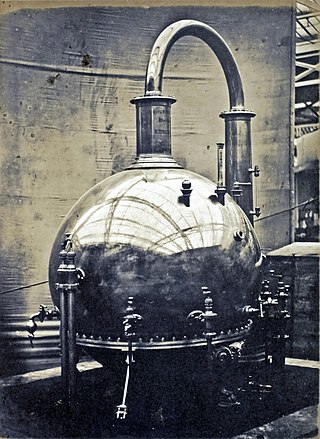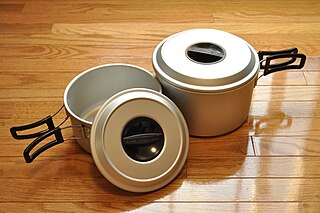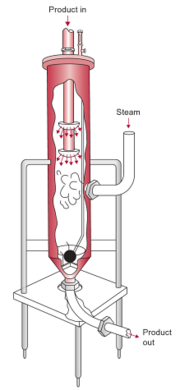
Pasteurization or pasteurisation is a process of food preservation in which packaged and non-packaged foods are treated with mild heat, usually to less than 100 °C (212 °F), to eliminate pathogens and extend shelf life. The process is intended to destroy or deactivate microorganisms and enzymes that contribute to food spoilage or risk of disease, including vegetative bacteria, but most bacterial spores survive the process.

Poaching is a cooking technique that involves heating food submerged in a liquid, such as water, milk, stock or wine. Poaching is differentiated from the other "moist heat" cooking methods, such as simmering and boiling, in that it uses a relatively lower temperature. This temperature range makes it particularly suitable for delicate food, such as eggs, poultry, fish and fruit, which might easily fall apart or dry out using other cooking methods. Poaching is often considered a healthy cooking method because it does not use fat for cooking or flavoring the food.

Ultra-high temperature processing (UHT), ultra-heat treatment, or ultra-pasteurization is a food processing technology that sterilizes liquid food by heating it above 140 °C (284 °F) – the temperature required to kill bacterial endospores – for 2 to 5 seconds. UHT is most commonly used in milk production, but the process is also used for fruit juices, cream, soy milk, yogurt, wine, soups, honey, and stews. UHT milk was first developed in the 1960s and became generally available for consumption in the 1970s. The heat used during the UHT process can cause Maillard browning and change the taste and smell of dairy products. An alternative process is flash pasteurization, in which the milk is heated to 72 °C (162 °F) for at least 15 seconds.

Processed cheese is a product made from cheese mixed with an emulsifying agent. Additional ingredients, such as vegetable oils, unfermented dairy ingredients, salt, food coloring, or sugar may be included. As a result, many flavors, colors, and textures of processed cheese exist. Processed cheese typically contains around 50 to 60% cheese and 40 to 50% other ingredients.

Joule heating is the process by which the passage of an electric current through a conductor produces heat.

Superheated steam is steam at a temperature higher than its vaporization point at the absolute pressure where the temperature is measured.

The following outline is provided as an overview of and topical guide to food preparation:

Vacuum evaporation is the process of causing the pressure in a liquid-filled container to be reduced below the vapor pressure of the liquid, causing the liquid to evaporate at a lower temperature than normal. Although the process can be applied to any type of liquid at any vapor pressure, it is generally used to describe the boiling of water by lowering the container's internal pressure below standard atmospheric pressure and causing the water to boil at room temperature.
Condensing boilers are water heaters typically used for heating systems that are fueled by gas or oil. When operated in the correct circumstances, a heating system can achieve high efficiency by condensing water vapour found in the exhaust gases in a heat exchanger to preheat the circulating water. This recovers the latent heat of vaporisation, which would otherwise have been wasted. The condensate is sent to a drain. In many countries, the use of condensing boilers is compulsory or encouraged with financial incentives.

An evaporator is a type of heat exchanger device that facilitates evaporation by utilizing conductive and convective heat transfer to provide the necessary thermal energy for phase transition from liquid to vapor. Within evaporators, a circulating liquid is exposed to an atmospheric or reduced pressure environment, causing it to boil at a lower temperature compared to normal atmospheric boiling.
Scalded milk is dairy milk that has been heated to 83 °C (181 °F). At this temperature, bacteria are killed, enzymes in the milk are destroyed, and many of the proteins are denatured. Since most milk sold today is pasteurized, which accomplishes the first two goals, milk is typically scalded to increase its temperature, or to change the consistency or other cooking interactions due to the denaturing of proteins.

Instant soup is a type of soup designed for fast and simple preparation. Some are homemade, and some are mass-produced on an industrial scale and treated in various ways to preserve them. A wide variety of types, styles and flavors of instant soups exist. Commercial instant soups are usually dried or dehydrated, canned, or treated by freezing.
Aseptic processing is a processing technique wherein commercially thermally sterilized liquid products are packaged into previously sterilized containers under sterile conditions to produce shelf-stable products that do not need refrigeration. Aseptic processing has almost completely replaced in-container sterilization of liquid foods, including milk, fruit juices and concentrates, cream, yogurt, salad dressing, liquid egg, and ice cream mix. There has been an increasing popularity for foods that contain small discrete particles, such as cottage cheese, baby foods, tomato products, fruit and vegetables, soups, and rice desserts.

Cooker may refer to several types of cooking appliances and devices used for cooking foods.

Pasteurized eggs are eggs that have been pasteurized in order to reduce the risk of foodborne illness in dishes that are not cooked or are only lightly cooked. They may be sold as liquid egg products or pasteurized in the shell.
A climbing/falling film plate evaporator is a specialized type of evaporator in which a thin film of liquid is passed over a rising and falling plate to allow the evaporation process to occur. It is an extension of the falling film evaporator, and has application in any field where the liquid to be evaporated cannot withstand extended exposure to high temperatures, such as the concentration of fruit juices.
Circulation evaporators are a type of evaporating unit designed to separate mixtures unable to be evaporated by a conventional evaporating unit. Circulation evaporation incorporates the use of both heat exchangers and flash separation units in conjunction with circulation of the solvent in order to remove liquid mixtures without conventional boiling. There are two types of Circulation Evaporation; Natural Circulation Evaporators and Forced Circulation Evaporators, both of which are still currently used in industry today, although forced Circulation systems, which have a circulation pump as opposed to natural systems with no driving force, have a much wider range of appropriate uses.
A rising film or vertical long tube evaporator is a type of evaporator that is essentially a vertical shell and tube heat exchanger. The liquid being evaporated is fed from the bottom into long tubes and heated with steam condensing on the outside of the tube from the shell side. This is to produce steam and vapour within the tube bringing the liquid inside to a boil. The vapour produced then presses the liquid against the walls of the tubes and causes the ascending force of this liquid. As more vapour is formed, the centre of the tube will have a higher velocity which forces the remaining liquid against the tube wall forming a thin film which moves upwards. This phenomenon of the rising film gives the evaporator its name.
Microwave volumetric heating (MVH) is a method of using microwaves to evenly heat the entire volume of a flowing liquid, suspension or semi-solid. The process is known as MVH because the microwaves penetrate uniformly throughout the volume of the product being heated, thus delivering energy evenly into the body of the material.













